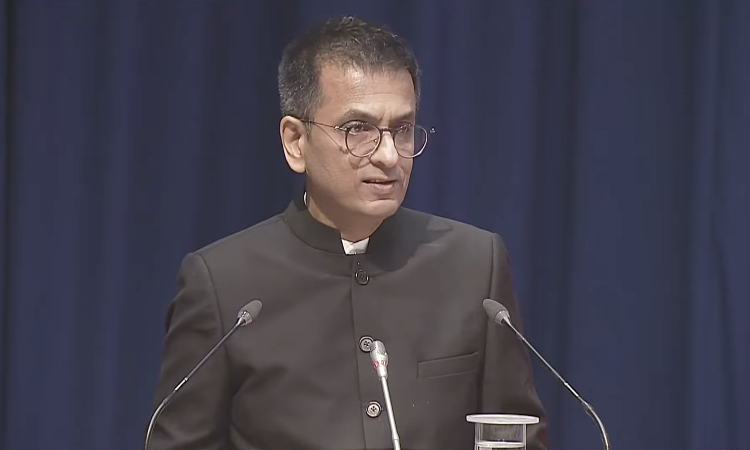- Home
- /
- Top Stories
- /
- Judiciary Must Reach Out To People...
Judiciary Must Reach Out To People Instead Of People Reaching Out To It: CJI DY Chandrachud On Constitution Day
Padmakshi Sharma
26 Nov 2022 1:22 PM IST
Chief Justice DY Chandrachud delivered an address on the Constitution Day celebrations held in the Supreme Court of India on 26th November 2022. Through his address, the Chief Justice highlighted the importance of technology in ensuring access to justice and the need for judiciary to reach people instead of people reaching out to the judiciary. CJI Chandrachud commenced his address by...
Chief Justice DY Chandrachud delivered an address on the Constitution Day celebrations held in the Supreme Court of India on 26th November 2022. Through his address, the Chief Justice highlighted the importance of technology in ensuring access to justice and the need for judiciary to reach people instead of people reaching out to the judiciary.
CJI Chandrachud commenced his address by stating that the Constitution of India was a social contract between those historically in power and those who had been marginalised. Highlighting the need to enhance the representation of marginalised communities in the legal profession, he said–
"The story of the Indian constitution is not just a story of legal text but is a story of human struggles and sacrifices, on undoing the injustices against the marginalised communities of society– the women, the Dalits and the disabled. The marginalised were the first to bring ideas or equality and liberty in the Indian law. The first wave of resistance against colonial power came from indigenous communities."
He underscored that the colonial courts often refused to interfere in cases involving socio-religious customs even if the rights of marginalised communities were in question. Thus, it was important that the judges in India, ranging from the district court to the Supreme Court, reflected upon securing the constitutional vision liberty, equality and fraternity. He added–
"I believe, as the Chief Justice of India, it is my responsibility to consult judges in the Supreme Court, the High Court and the district judiciary. It is important to tap into the rich experience of all the members of the judiciary. The representation of marginalised communities must be enhanced in the legal profession."
Stating that the jurisprudence that emanated from Indian courts influenced decisions in South Africa, Kenya, Australia, Jamaica, Uganda, Bangladesh, Singapore, Fiji among others, CJI Chandrachud highlighted that in a nation as diverse as India, the paramount challenge that the judiciary faced was the accessibility of justice. In this context, he said–
"It's essential that the judiciary reaches people and not expect the people to reach out judiciary. The infrastructure of technology must not be dismantled. Though the Supreme Court is located at Tilak Marg, it is the Supreme Court for the entire nation. The virtual access has made it possible for lawyers to argue cases from their own places. As a CJI, I am looking to adopt technology in listing of cases and court hearings, which will help to weed out institutional flaws such as delay in listing and hearing."
CJI Chandrachud also stated that the National Judicial Data Grid was now a repository of 77 lakh judgments of the High Courts that were available to all citizens free of cost. Urging the technological framework introduced during the COVID-19 pandemic to be augmented instead of dismantled, CJI Chandrachud also called for institutional reforms to resolve issues of access to justice. He stated that since the district judiciary was the first point of contact for access to justice, it had to be uplifted and strengthened.
Before concluding his address, CJI Chandrachud gave an overview of the initiatives being launched by the Prime Minister under the e-court's project. The initiatives include:
1. Virtual Justice Clock: Virtual Justice Clock is an initiative to exhibit vital statistics of the justice delivery system at the Court level giving the details of the cases instituted, cases disposed and pendency of cases on day/week/month basis at the Court level. The effort is to make the functioning of the courts accountable and transparent by sharing with the public the status of case disposals by the court. Public can access the Virtual Justice Clock of any court establishment on the District Court's website.
2. JustIS mobile App 2.0: JustIS Mobile App 2.0 is a tool available to judicial officers for effective court and case management by monitoring pendency and disposal of not only his court but also for individual judges working under them. This App is also made available to High Court and Supreme Court Judges who can now monitor pendency and disposal of all the States and Districts under their jurisdiction.
3. Digital court: Digital court is an initiative to make the court records available to the judge in digitised form to enable the transition to Paperless Courts.
4. S3WaaS Websites: S3WaaS Websites is a framework to generate, configure, deploy and manage websites for publishing specified information and services related to district judiciary. S3WaaS is a cloud service developed for government entities to generate Secure, Scalable & Sugamya (Accessible) websites. It is multilingual, citizen friendly and divyang friendly.


